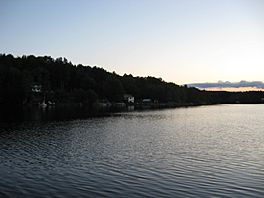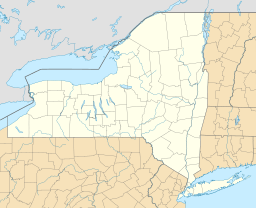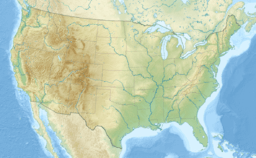Mountain Lake (New York) facts for kids
Quick facts for kids Mountain Lake |
|
|---|---|

Mountain Lake during the summer.
|
|
| Location | Adirondack Park, Fulton County, New York, US |
| Coordinates | 43°06′23″N 74°22′11″W / 43.10639°N 74.36972°W |
| Primary inflows | Spring fed |
| Primary outflows | Dam on north western end |
| Catchment area | Vandenburg Pond |
| Basin countries | United States |
| Max. length | 300 m (980 ft) |
| Max. width | 100 m (330 ft) |
| Average depth | 6 to 10 m (20 to 33 ft) |
| Max. depth | 15 m (49 ft) |
| Residence time | seasonal to permanent |
| Islands | Elmer Island, a small island made up of mostly rock. |
| Settlements | Gloversville |
Mountain Lake is a beautiful lake found in the southern part of Adirondack Park in Bleecker, New York. It is located just west of the larger Great Sacandaga Lake. Long ago, in the 1800s, this lake was known as Carpenter's Lake.
The lake has one small island called Elmer Island. This island is mostly made of rock and is located towards the western end of the lake. There is also a dam on the northwestern side of the lake. Water from the lake flows out through this dam into a place called Vandenburgh Pond.
Many years ago, when the local towns were busy making leather and gloves, Mountain Lake was a very popular vacation spot. People from nearby Gloversville and Johnstown loved to visit the lake in the late 1700s and early 1800s. There was even an electric train line that took vacationers from Gloversville up Bleecker Mountain right to a station at the lake! This train line was once owned by the FJ&G RR Co.
Contents
History of Mountain Lake
The Mountain Lake Hotel
In the early 1900s, there was a hotel right on the shores of Mountain Lake. It was a popular place for visitors to stay. Sadly, the hotel was later destroyed by a fire.
The Mountain Lake Train Accident
On July 4, 1902, a sad event happened on the Mountain Lake Railroad. Around 9:20 p.m., two trains crashed into each other. This accident resulted in 14 people losing their lives and many others being injured. You can learn more about this event and see old postcards of the area from the early 1900s by visiting this website: [1]
Images for kids





